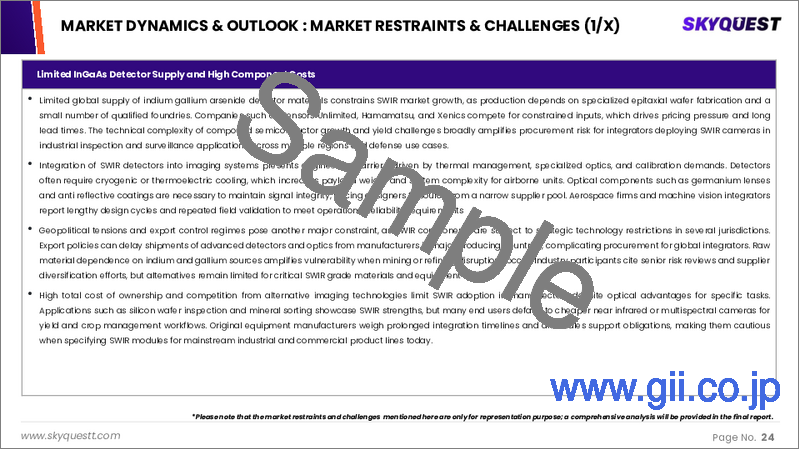|
|
市場調査レポート
商品コード
1687554
短波赤外線の市場規模、シェア、成長分析:イメージングタイプ別、オファリング別、技術別、使用事例別、業界別、地域別 - 産業予測、2025年~2032年Shortwave Infrared Market Size, Share, and Growth Analysis, By Imaging Type (Spectral Imaging, Thermal Imaging), By Offering (Modules, Cameras), By Technology, By Use-case, By Vertical, By Region - Industry Forecast 2025-2032 |
||||||
|
|||||||
| 短波赤外線の市場規模、シェア、成長分析:イメージングタイプ別、オファリング別、技術別、使用事例別、業界別、地域別 - 産業予測、2025年~2032年 |
|
出版日: 2025年03月17日
発行: SkyQuest
ページ情報: 英文 197 Pages
納期: 3~5営業日
|
全表示
- 概要
- 目次
短波赤外線の市場規模は2023年に6億3,400万米ドルと評価され、2024年の7億501万米ドルから2032年までには16億4,829万米ドルに成長し、予測期間(2025年~2032年)のCAGRは11.2%で成長する見通しです。
世界の短波赤外線(SWIR)市場は、防衛、セキュリティ、ヘルスケアなど様々な分野での多用途に後押しされ、消費者の選好の顕著な変化を目の当たりにしています。1.4ミクロンから3ミクロンの波長能力を活用するSWIR技術は、霧や煙のような困難な状況をナビゲートする能力があるため、ナイトビジョン、監視、ターゲット検出のための防衛で特に支持されています。初期コストが高く、消費者の知識が限られていることが課題となっていますが、現在進行中の進歩は、有効性の向上とコストの削減を目指しており、よりコンパクトで手頃な価格のSWIRソリューションの開発につながっています。SWIRの利点に対する認識が高まり、品質管理や欠陥検出などの産業用途が拡大するにつれて、市場は持続的な成長と革新を遂げる態勢が整っています。
目次
イントロダクション
- 調査の目的
- 調査範囲
- 定義
調査手法
- 情報調達
- 二次と一次データの方法
- 市場規模予測
- 市場の前提条件と制限
エグゼクティブサマリー
- 世界市場の見通し
- 供給と需要の動向分析
- セグメント別機会分析
市場力学と見通し
- 市場概要
- 市場規模
- 市場力学
- 促進要因と機会
- 抑制要因と課題
- ポーターの分析
主要な市場の考察
- 主要成功要因
- 競合の程度
- 主要な投資機会
- 市場エコシステム
- 市場の魅力指数(2024年)
- PESTEL分析
- マクロ経済指標
- バリューチェーン分析
- 価格分析
- 技術の進歩
短波赤外線市場規模:イメージングタイプ別・CAGR(2025年~2032年)
- 市場概要
- スペクトルイメージング
- エリアスキャン
- ラインスキャン
- 熱画像
- アクティブ
- パッシブ
- ハイパースペクトルイメージング
- プッシュブルーム
- スナップショット
- その他のイメージングタイプ
短波赤外線市場規模:オファリング別・CAGR(2025年~2032年)
- 市場概要
- モジュール
- カメラ
- ソフトウェア
- サービス
短波赤外線市場規模:技術別・CAGR(2025年~2032年)
- 市場概要
- 冷却
- 非冷却
短波赤外線市場規模:使用事例別・CAGR(2025年~2032年)
- 市場概要
- セキュリティ・監視
- 監視・検査
- 検出
短波赤外線市場規模:業界別・CAGR(2025年~2032年)
- 市場概要
- 電子工学・通信
- 軍事・防衛
- 医療・ヘルスケア
- 食品・飲料
- 自動車
- その他
短波赤外線市場規模・CAGR(2025年~2032年)
- 北米
- 米国
- カナダ
- 欧州
- ドイツ
- スペイン
- フランス
- 英国
- イタリア
- その他欧州地域
- アジア太平洋
- 中国
- インド
- 日本
- 韓国
- その他アジア太平洋
- ラテンアメリカ
- ブラジル
- その他ラテンアメリカ地域
- 中東・アフリカ
- GCC諸国
- 南アフリカ
- その他中東・アフリカ
競合情報
- 上位5社の比較
- 主要企業の市場ポジショニング(2024年)
- 主な市場企業が採用した戦略
- 最近の市場動向
- 企業の市場シェア分析(2024年)
- 主要企業の企業プロファイル
- 企業の詳細
- 製品ポートフォリオ分析
- 企業のセグメント別シェア分析
- 収益の前年比比較(2022年~2024年)
主要企業プロファイル
- Allied Vision Technologies GmbH(Germany)
- Hamamatsu Photonics K.K.(Japan)
- Raptor Photonics Ltd.(United Kingdom)
- Photon etc.(Canada)
- Princeton Infrared Technologies, Inc.(USA)
- Lynred(France)
- InView Technology Corporation(USA)
- New Imaging Technologies(NIT)(France)
- Sensors Unlimited, Inc.(USA)
- Xenics NV(Belgium)
- InfraTec GmbH(Germany)
- IRnova AB(Sweden)
- Sofradir(France)
- FLIR Systems, Inc.(USA)
- Leonardo DRS(USA)
- Ophir Optronics Solutions(Israel)
- Telops Inc.(Canada)
- SCD-SemiConductor Devices(Israel)
- Emberion Oy(Finland)
結論と提言
Shortwave Infrared Market size was valued at USD 634.0 million in 2023 and is poised to grow from USD 705.01 million in 2024 to USD 1648.29 million by 2032, growing at a CAGR of 11.2% during the forecast period (2025-2032).
The global Shortwave Infrared (SWIR) market is witnessing a notable shift in consumer preferences, fueled by its versatile applications across various sectors, including defense, security, and healthcare. Leveraging wavelength capabilities from 1.4 to 3 microns, SWIR technology is particularly favored in defense for night vision, surveillance, and target detection due to its ability to navigate challenging conditions like fog and smoke. Despite high initial costs and limited consumer knowledge posing challenges, ongoing advancements aim to enhance efficacy and reduce costs, leading to the development of more compact and affordable SWIR solutions. As awareness of SWIR's benefits grows and its industrial applications, such as quality control and defect detection, expand, the market is poised for sustained growth and innovation.
Top-down and bottom-up approaches were used to estimate and validate the size of the Shortwave Infrared market and to estimate the size of various other dependent submarkets. The research methodology used to estimate the market size includes the following details: The key players in the market were identified through secondary research, and their market shares in the respective regions were determined through primary and secondary research. This entire procedure includes the study of the annual and financial reports of the top market players and extensive interviews for key insights from industry leaders such as CEOs, VPs, directors, and marketing executives. All percentage shares split, and breakdowns were determined using secondary sources and verified through Primary sources. All possible parameters that affect the markets covered in this research study have been accounted for, viewed in extensive detail, verified through primary research, and analyzed to get the final quantitative and qualitative data.
Shortwave Infrared Market Segments Analysis
Global Shortwave Infrared Market is segmented by Imaging Type, Offering, Technology, Use-case, Vertical and region. Based on Imaging Type, the market is segmented into Spectral Imaging, Thermal Imaging and Hyperspectral Imaging. Based on Offering, the market is segmented into Modules, Cameras, Software and Services. Based on Technology, the market is segmented into Cooled and Uncooled. Based on Use-case, the market is segmented into Security & surveillance, Monitoring & Inspection and Detection. Based on Vertical, the market is segmented into Electronics and Communication, Military and Defence, Medical and Healthcare, Food & Beverage, Automotive and Others. Based on region, the market is segmented into North America, Europe, Asia Pacific, Latin America and Middle East & Africa.
Driver of the Shortwave Infrared Market
The growth of the Shortwave Infrared (SWIR) market is significantly influenced by the rising demand for advanced imaging technologies within the defense and security sectors. SWIR plays a crucial role in night vision, surveillance, and target detection, making it invaluable for military applications worldwide. Additionally, its expanding use in industrial production-especially for quality control and inspection purposes-further drives demand. Industries such as semiconductor manufacturing and electronics benefit from SWIR's ability to detect faults and provide high-resolution imagery, enhancing overall manufacturing processes. This interplay of defense needs and industrial applications underscores SWIR's growing significance in various sectors.
Restraints in the Shortwave Infrared Market
One of the primary constraints facing the Shortwave Infrared (SWIR) market is the substantial initial investment required for SWIR technology. The intricate materials and complex manufacturing processes necessary for producing SWIR cameras and sensors significantly inflate production costs, making the technology inaccessible to a wide range of potential users. Additionally, the lack of awareness regarding the advantages of SWIR technology may impede broader industry acceptance. This situation could be particularly detrimental to sectors that have not yet harnessed the benefits offered by SWIR, particularly in applications like night vision, surveillance, and inspection during manufacturing processes.
Market Trends of the Shortwave Infrared Market
The Shortwave Infrared (SWIR) market is witnessing a notable upward trend driven by the increasing adoption of SWIR technology in unmanned aerial vehicles (UAVs) and autonomous systems. This technology enhances surveillance, target recognition, and navigation capabilities, leading to a surge in the deployment of sophisticated autonomous solutions. Simultaneously, the agricultural sector is embracing SWIR imaging to monitor crop health, optimize irrigation practices, and advance precision agriculture techniques. As industries recognize the multifunctional benefits of SWIR technology, from enhancing operational efficiency in UAVs to revolutionizing agricultural practices, the demand for SWIR sensors is set to expand significantly in the coming years.
Table of Contents
Introduction
- Objectives of the Study
- Scope of the Report
- Definitions
Research Methodology
- Information Procurement
- Secondary & Primary Data Methods
- Market Size Estimation
- Market Assumptions & Limitations
Executive Summary
- Global Market Outlook
- Supply & Demand Trend Analysis
- Segmental Opportunity Analysis
Market Dynamics & Outlook
- Market Overview
- Market Size
- Market Dynamics
- Drivers & Opportunities
- Restraints & Challenges
- Porters Analysis
- Competitive rivalry
- Threat of substitute
- Bargaining power of buyers
- Threat of new entrants
- Bargaining power of suppliers
Key Market Insights
- Key Success Factors
- Degree of Competition
- Top Investment Pockets
- Market Ecosystem
- Market Attractiveness Index, 2024
- PESTEL Analysis
- Macro-Economic Indicators
- Value Chain Analysis
- Pricing Analysis
- Technological Advancement
Global Shortwave Infrared Market Size by Imaging Type & CAGR (2025-2032)
- Market Overview
- Spectral Imaging
- Area Scan
- Line Scan
- Thermal Imaging
- Active
- Passive
- Hyperspectral Imaging
- Pushbroom
- Snapshot
- Other Imaging Types
Global Shortwave Infrared Market Size by Offering & CAGR (2025-2032)
- Market Overview
- Modules
- Cameras
- Software
- Services
Global Shortwave Infrared Market Size by Technology & CAGR (2025-2032)
- Market Overview
- Cooled
- Uncooled
Global Shortwave Infrared Market Size by Use-case & CAGR (2025-2032)
- Market Overview
- Security & surveillance
- Monitoring & Inspection
- Detection
Global Shortwave Infrared Market Size by Vertical & CAGR (2025-2032)
- Market Overview
- Electronics and Communication
- Military and Defence
- Medical and Healthcare
- Food & Beverage
- Automotive
- Others
Global Shortwave Infrared Market Size & CAGR (2025-2032)
- North America (Imaging Type, Offering, Technology, Use-case, Vertical)
- US
- Canada
- Europe (Imaging Type, Offering, Technology, Use-case, Vertical)
- Germany
- Spain
- France
- UK
- Italy
- Rest of Europe
- Asia Pacific (Imaging Type, Offering, Technology, Use-case, Vertical)
- China
- India
- Japan
- South Korea
- Rest of Asia-Pacific
- Latin America (Imaging Type, Offering, Technology, Use-case, Vertical)
- Brazil
- Rest of Latin America
- Middle East & Africa (Imaging Type, Offering, Technology, Use-case, Vertical)
- GCC Countries
- South Africa
- Rest of Middle East & Africa
Competitive Intelligence
- Top 5 Player Comparison
- Market Positioning of Key Players, 2024
- Strategies Adopted by Key Market Players
- Recent Developments in the Market
- Company Market Share Analysis, 2024
- Company Profiles of All Key Players
- Company Details
- Product Portfolio Analysis
- Company's Segmental Share Analysis
- Revenue Y-O-Y Comparison (2022-2024)
Key Company Profiles
- Allied Vision Technologies GmbH (Germany)
- Company Overview
- Business Segment Overview
- Financial Updates
- Key Developments
- Hamamatsu Photonics K.K. (Japan)
- Company Overview
- Business Segment Overview
- Financial Updates
- Key Developments
- Raptor Photonics Ltd. (United Kingdom)
- Company Overview
- Business Segment Overview
- Financial Updates
- Key Developments
- Photon etc. (Canada)
- Company Overview
- Business Segment Overview
- Financial Updates
- Key Developments
- Princeton Infrared Technologies, Inc. (USA)
- Company Overview
- Business Segment Overview
- Financial Updates
- Key Developments
- Lynred (France)
- Company Overview
- Business Segment Overview
- Financial Updates
- Key Developments
- InView Technology Corporation (USA)
- Company Overview
- Business Segment Overview
- Financial Updates
- Key Developments
- New Imaging Technologies (NIT) (France)
- Company Overview
- Business Segment Overview
- Financial Updates
- Key Developments
- Sensors Unlimited, Inc. (USA)
- Company Overview
- Business Segment Overview
- Financial Updates
- Key Developments
- Xenics NV (Belgium)
- Company Overview
- Business Segment Overview
- Financial Updates
- Key Developments
- InfraTec GmbH (Germany)
- Company Overview
- Business Segment Overview
- Financial Updates
- Key Developments
- IRnova AB (Sweden)
- Company Overview
- Business Segment Overview
- Financial Updates
- Key Developments
- Sofradir (France)
- Company Overview
- Business Segment Overview
- Financial Updates
- Key Developments
- FLIR Systems, Inc. (USA)
- Company Overview
- Business Segment Overview
- Financial Updates
- Key Developments
- Leonardo DRS (USA)
- Company Overview
- Business Segment Overview
- Financial Updates
- Key Developments
- Ophir Optronics Solutions (Israel)
- Company Overview
- Business Segment Overview
- Financial Updates
- Key Developments
- Telops Inc. (Canada)
- Company Overview
- Business Segment Overview
- Financial Updates
- Key Developments
- SCD - SemiConductor Devices (Israel)
- Company Overview
- Business Segment Overview
- Financial Updates
- Key Developments
- Emberion Oy (Finland)
- Company Overview
- Business Segment Overview
- Financial Updates
- Key Developments






